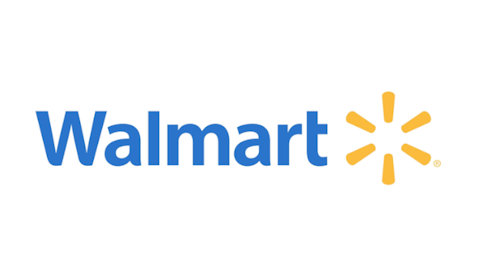
WMT Total Return Price data by YCharts
Amazon.com, Inc. (NASDAQ:AMZN) started off selling books, and then it branched into selling all sorts of products. Now it functions more like a search engine. Some estimate that more than half of Amazon’s sales come from third parties. This serves as both an asset and a risk. Relying on third party sellers means that Amazon needs to carry fewer goods on its balance sheet and it can make money from high margin listing fees. The downside is that if Amazon upsets these third party sellers, they can take their business elsewhere.
Many investors have been weary of Amazon.com, Inc. (NASDAQ:AMZN) due to its lack of profits. The company counters that it is simply reinvesting for the future and it will open up the profit flood gates at some point. There is definitely merit to this argument. If Amazon’s profit margin was around Wal-Mart Stores, Inc. (NYSE:WMT)’s 3.8% instead of -0.1%, then it would be trading at a price to earnings (P/E) ratio around 60. Given Amazon’s high growth this valuation is somewhat reasonable.
The downside to Amazon is that it still looks like a company looking for its commercial purpose. It operates an ecommerce operation, cloud computing service, an online video service, a content delivery network, and a search engine. Operating all of these separate businesses is expensive and has helped to drive down its free cash flow to $0.485 per share over the trailing 12 months. As soon as revenue growth substantially slows down, the stock could crash.
Amazon.com, Inc. (NASDAQ:AMZN) is a great stock for traders, but investors with 10 year time frames need a concrete profit plan. It is unclear if Amazon will ever be able to offer profits in addition to growth.
WMT Free Cash Flow Per Share TTM data by YCharts
The market loves growth, and Wal-Mart Stores, Inc. (NYSE:WMT) has already expanded overseas. With annual sales over $450 billion, it is a huge portion of the world economy. The urbanization of China will boost the company’s bottom line, but it is also growing elsewhere. The company says that it expects to do $10 billion in online sales in 2014. Wal-Mart Stores, Inc. (NYSE:WMT) has strong potential to grow online as Amazon.com, Inc. (NASDAQ:AMZN) alone has total annual sales around $60 billion.
It is much easier for Wal-Mart to make inroads into the ecommerce market, than it is for Amazon to make inroads into the traditional brick and mortar market. There are only a few potential ways for Wal-Mart Stores, Inc. (NYSE:WMT) to substantially increase its growth, and ecommerce is the one of them. Soon or later, Wal-Mart will start attacking Amazon’s home turf.
Wal-Mart and Amazon both go after the price conscious consumer. They buy in bulk and offer low prices, but Wal-Mart makes profits. A critical catalyst is the prospect of a national internet tax bill. Governments are always hungry for taxes, and sooner or later Amazon will have to charge more taxes on its goods, thus bringing its prices inline to Wal-Mart’s.
Quality growth
Wal-Mart is a consistent free cash flow producer, just like Costco Wholesale Corporation (NASDAQ:COST). Wal-Mart’s trailing 12 month free cash flow per share is $3.40 and Costco’s is $3.70. Costco Wholesale Corporation (NASDAQ:COST) shows that it is possible to compete with Wal-Mart, grow and be profitable. Critically, Costco differentiates itself from Wal-Mart by targeting higher income demographics. The company offers fewer goods in massive warehouses to increase efficiency.
Costco Wholesale Corporation (NASDAQ:COST)‘s annual sales around $50 billion give it room for growth. The company has experience outside of the U.S. with 33 stores in Mexico and 24 in the United Kingdom, in addition to a number of other countries. It is taking international expansion seriously, as it recently bought out its Mexican joint venture partner to give it more control in Latin America.
Costco’s profit margin of 2.0% and total debt to equity ratio of 0.47 are relatively healthy. Its P/E ratio of 25.1 isn’t cheap, but the company has substantial room to grow, and produces a healthy amount of free cash flow.
Conclusion
Wal-Mart Stores, Inc. (NYSE:WMT) is a better long term investment than Amazon.com, Inc. (NASDAQ:AMZN). Amazon is innovative, but a lack of profits, falling free cash flow and an awkward mix of physical and electronic products do not paint a pretty picture. With an internet tax bill looming in the distance, Wal-Mart will be able to keep its pricing advantage and move online. Fundamental investors looking for growth will find a better fit with Costco. The company is profitable, consistently produces free cash flow, has room to grow and has proven its ability to fend off Wal-Mart.
The article Wal-Mart or Amazon, Which Is Better? originally appeared on Fool.com and is written by Joshua Bondy.
Joshua Bondy has no position in any stocks mentioned. The Motley Fool recommends Amazon.com and Costco Wholesale (NASDAQ:COST). The Motley Fool owns shares of Amazon.com and Costco Wholesale. Joshua is a member of The Motley Fool Blog Network — entries represent the personal opinion of the blogger and are not formally edited.
Copyright © 1995 – 2013 The Motley Fool, LLC. All rights reserved. The Motley Fool has a disclosure policy.







